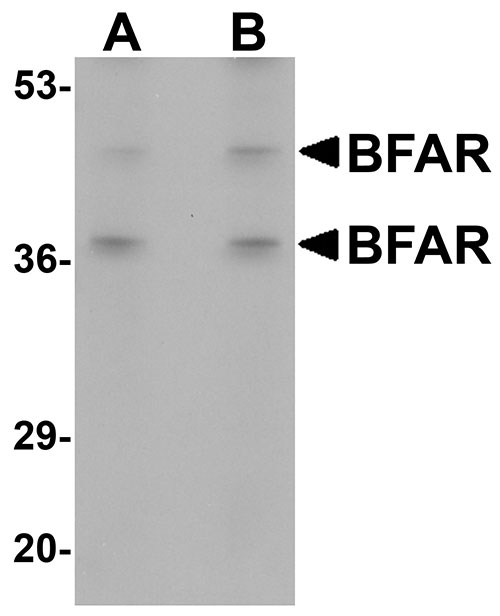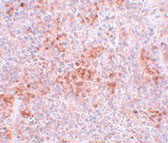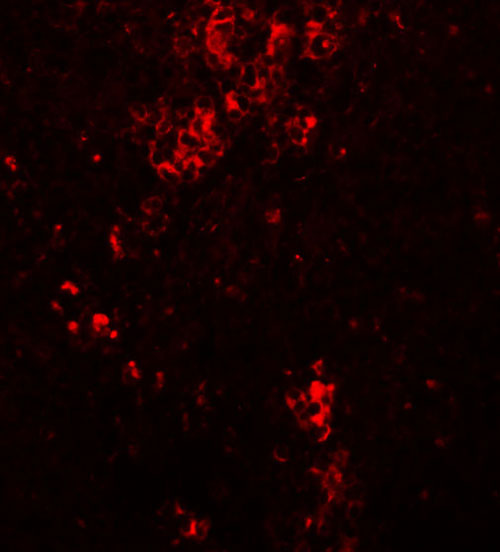BFAR Antibody
- 产品详情
- 实验流程
- 背景知识
Application
| WB, IF, E, IHC-P |
|---|---|
| Primary Accession | Q9NZS9 |
| Other Accession | NP_057645, 7706091 |
| Reactivity | Human, Mouse, Rat |
| Host | Rabbit |
| Clonality | Polyclonal |
| Isotype | IgG |
| Calculated MW | 52738 Da |
| Concentration (mg/ml) | 1 mg/mL |
| Conjugate | Unconjugated |
| Application Notes | BFAR antibody can be used for detection of BFAR by Western blot at 1 - 2 µg/mL. Antibody can also be used for immunohistochemistry starting at 5 µg/mL. For immunofluorescence start at 20 µg/mL. |
| Gene ID | 51283 |
|---|---|
| Other Names | Bifunctional apoptosis regulator, RING finger protein 47, BFAR, BAR, RNF47 |
| Target/Specificity | BFAR; |
| Reconstitution & Storage | BFAR antibody can be stored at 4℃ for three months and -20℃, stable for up to one year. As with all antibodies care should be taken to avoid repeated freeze thaw cycles. Antibodies should not be exposed to prolonged high temperatures. |
| Precautions | BFAR Antibody is for research use only and not for use in diagnostic or therapeutic procedures. |
| Name | BFAR |
|---|---|
| Synonyms | BAR, RNF47 |
| Function | Membrane-bound E3 ubiquitin ligase that plays a role in several processes including apoptosis regulation or reticulum endoplasmic stress (PubMed:14502241, PubMed:21068390). Has anti- apoptotic activity, both for apoptosis triggered via death-receptors and via mitochondrial factors (PubMed:14502241). Contributes to the dynamic control of IRE1/ERN1 signaling during ER stress by inducing BAX inhibitor 1/TMBIM6 proteasomal degradation (PubMed:21068390). Promotes the activation of TGF-beta signaling by mediating the 'Lys-63'-linked ubiquitination of TGFBR1 which is critical to activate the pathway (PubMed:33914044). Together with NGFR, negatively regulates NF-kappa-B and JNK-related signaling pathways (PubMed:22566094). Promotes the proteasome-mediated degradation of PNPLA3, a protein involveld in lipid metabolism (PubMed:38294943). |
| Cellular Location | Endoplasmic reticulum membrane; Multi-pass membrane protein |
| Tissue Location | Expressed highly in brain, moderately in small intestine, weakly in testes and only faintly in liver and skeletal muscle. Not expressed in heart, kidney, lung and spleen |
For Research Use Only. Not For Use In Diagnostic Procedures.
Provided below are standard protocols that you may find useful for product applications.
BACKGROUND
BFAR Antibody: The bifunctional apoptosis inhibitor (BFAR) is scaffold protein that integrates signaling components of the cells apoptosis-regulatory machinery. BFAR is a multidomain protein capable of inhibiting apoptosis induced by TNF-family death receptors ('extrinsic pathway') as well as mitochondria-dependent apoptosis ('intrinsic pathway'). Interaction of BFAR with Bcl-2 or Bcl-XL via a SAM domain may contribute to the anti-apoptotic properties of BFAR. In addition, BFAR contains a DED-like domain that is capable of suppressing apoptosis mediated at the receptor level. BFAR is also thought to be involved in the regulation of neuronal survival.
REFERENCES
Zhang H, Xu Q, Krajewski S, et al. BAR: an apoptosis regulator at the intersection of caspases and Bcl-2 family proteins. Proc. Natl. Acad. Sci. USA2000; 97:2597-602.
Roth W, Kermer P, Krajewska M, et al. Bifunctional apoptosis inhibitor (BAR) protects neurons from diverse cell death pathways. Cell Death Differ. 2003; 10: 1178-87.
终于等到您。ABCEPTA(百远生物)抗体产品。
点击下方“我要评价 ”按钮提交您的反馈信息,您的反馈和评价是我们最宝贵的财富之一,
我们将在1-3个工作日内处理您的反馈信息。
如有疑问,联系:0512-88856768 tech-china@abcepta.com.























 癌症的基本特征包括细胞增殖、血管生成、迁移、凋亡逃避机制和细胞永生等。找到癌症发生过程中这些通路的关键标记物和对应的抗体用于检测至关重要。
癌症的基本特征包括细胞增殖、血管生成、迁移、凋亡逃避机制和细胞永生等。找到癌症发生过程中这些通路的关键标记物和对应的抗体用于检测至关重要。 为您推荐一个泛素化位点预测神器——泛素化分析工具,可以为您的蛋白的泛素化位点作出预测和评分。
为您推荐一个泛素化位点预测神器——泛素化分析工具,可以为您的蛋白的泛素化位点作出预测和评分。 细胞自噬受体图形绘图工具为你的蛋白的细胞受体结合位点作出预测和评分,识别结合到自噬通路中的蛋白是非常重要的,便于让我们理解自噬在正常生理、病理过程中的作用,如发育、细胞分化、神经退化性疾病、压力条件下、感染和癌症。
细胞自噬受体图形绘图工具为你的蛋白的细胞受体结合位点作出预测和评分,识别结合到自噬通路中的蛋白是非常重要的,便于让我们理解自噬在正常生理、病理过程中的作用,如发育、细胞分化、神经退化性疾病、压力条件下、感染和癌症。








